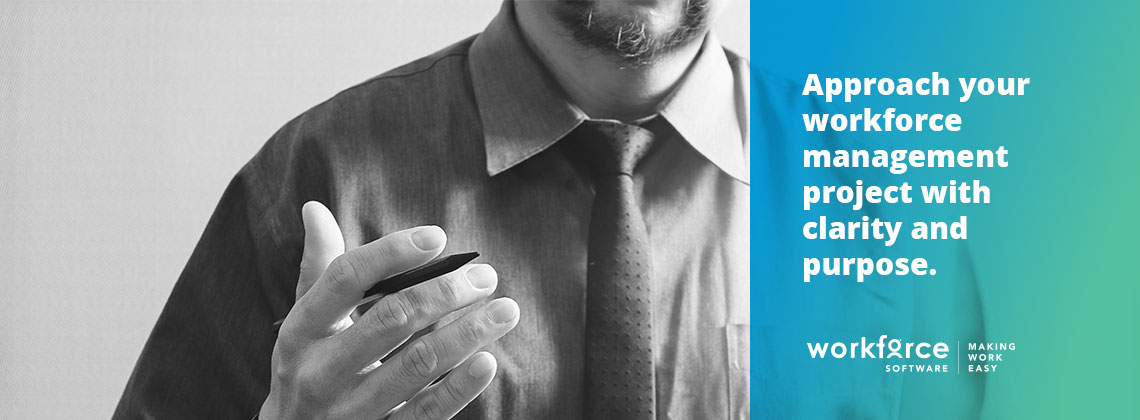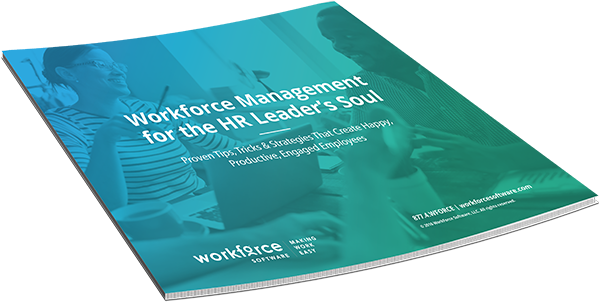What to Think About Before Starting a Workforce Management Project

7 honest, unbiased tips to help you.
Jared, from the payroll department, knocked on his director’s door.
“Come in.”
“I just got off a call with the implementation specialist,” said Jared, closing the door behind him.
“Yes, of course, sorry I had to miss it. Did she team up with the account exec to give you the hard sell?”
“Not at all,” said Jared. “She actually came with some objective advice: Things to think about before we dive any deeper…”
“That’s unusual.”
“Yeah, it is,” said Jared. “But these guys are different. I don’t think they’re selling to just anyone. They’re focused on long-term partnership, on sustained success.”
“That’s what we want. That’s what we need to bring to the executive team. What was her advice?”
“Well,” said Jared, flipping through his notes, “she said to think about…”
Subscribe to The WorkForce Blog
Learn the art and science of maintaining productive, happy, engaged employees.
1. Current processes
Analyze your processes to determine if they were put in place solely to appease your current, faulty system. After all, you don’t want to replicate unnecessary practices in the new system—this is your chance to let them go!
WFM advice: Don’t replicate unnecessary practices in your new system—this is your chance to let them go!
Also, challenge yourself to identify ineffective processes that can be changed prior to automating them. Don’t expect the workforce management solution to fully mirror how your business currently operates.
2. Leveraging the input of employees currently using the processes
Identify who’s in charge of ensuring that current processes run smoothly, then interview everyone using the processes to uncover any overlapping pain points.
These variables will help the outside implementation team align itself with your staff, not to mention your end-goals.
3. The “Curse”
The Curse of Knowledge is a cognitive bias that leaves victims unable to imagine what it’s like to not know or understand something, which, as a result, makes it difficult to communicate that knowledge to a less-informed person.
You understand your business better than even the brightest outside implementation expert. That puts the onus on you to enter into the process with clear expectations, providing plenty of context and perspective along the way.
Paint a picture. Start by answering these questions:
- How do you want the system to work?
- What impact can it have on your resources?
- What are the challenges you want the new system to correct?
- What benefits does your organization expect to realize at the end of the process?
Also, be prepared to answer difficult questions about how your business operates. Doing so will help fill in any blanks the Curse of Knowledge may have caused.
4. Time
Give team members time to work on the project.
This may seem obvious, but many managers don’t think about it, and expect their people to fit these new support responsibilities in alongside their day jobs.
A workforce management project requires mutual dedication, from the customer as well as the provider.
 Workforce Management for the HR Leader’s Soul
Workforce Management for the HR Leader’s Soul
This book will help you create a healthy, rewarding environment for the people that keep your company moving forward.
5. Transparency
Clearly and consistently communicate deadline-driven goals to team members who are directly, or indirectly, involved in the process.
It’s the only way to avoid costly surprises.
6. Technical support and long-term maintenance
Will your team be responsible for the system’s technical maintenance? Or will you outsource that work?
As your business gradually changes and evolves (e.g., mergers & acquisitions, revised CBAs, changing laws, etc.) how will you adapt your policies and system features to align.
Who will make those decisions? Who will make those changes? Who will orchestrate the technical teams to bring it all to life? All things to consider.
7. A multi-phase approach
The goal, ultimately, is to realize value from your new system.
To do so, plan on an ongoing, multi-phase approach to implement the added value items, an agile approach. An approach that enables the system to evolve naturally, in line with your needs that quarter—not the needs you had years ago, when the system was first introduced.
It’s important to not over-engineer the system up-front but, rather, to start using it as quickly as possible so that you and your teams learn what works and what doesn’t, and can adjust.
Agile methodology is the fastest approach to realizing value from your new workforce management system.
3 months later…
Sonia, from the implementation team, knocked on her manager’s door.
“Come in.”
“I just got off a conference call with Jared, the payroll specialist, and his director,” said Sonia, closing the door behind her.
“How did it go?”
“Well…” said Sonia, as she smiled and opened her notes.
Start smart. Finish well.
Our workforce management experts will help.

 Workforce Management for the HR Leader’s Soul
Workforce Management for the HR Leader’s Soul